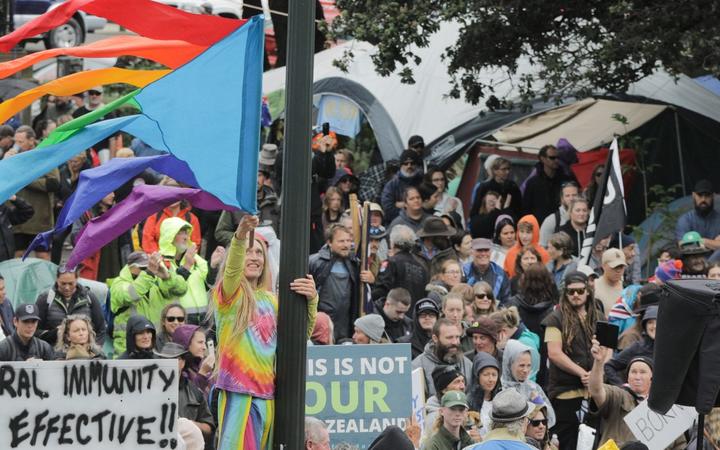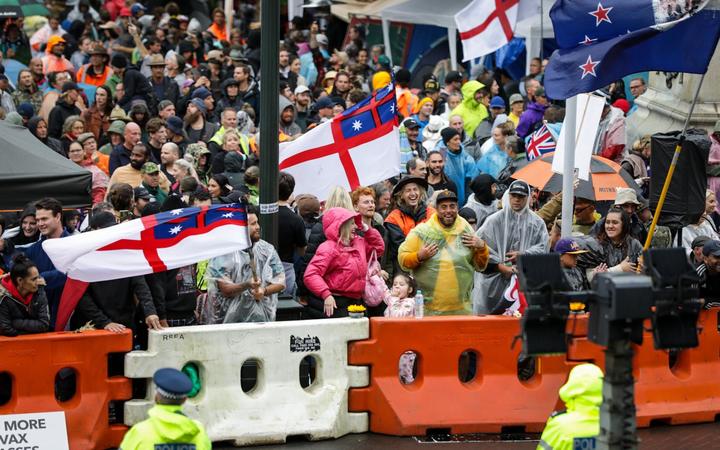Opinion – Over the past year as the J.D. Stout Research Fellow I’ve been working on a book about the counterculture: the loose amalgam of radical causes that rose in the 1960s and ’70s to challenge many of society’s long-held conventions.
 Protesters at Parliament on 14 February. Photo: RNZ / Angus Dreaver
Protesters at Parliament on 14 February. Photo: RNZ / Angus Dreaver
While the movement was global, my interest is in the particular shape it took in New Zealand, where its constituents ranged from political activists outraged by the Vietnam War and South African apartheid, to hedonists who wanted to take illegal drugs like marijuana and LSD or embrace such alternative concepts as communal living and herbal medicines, eastern spirituality and sexual diversity. If there was a single word that was used most often to sum up its ethos it was: Freedom.
Watching the anti-mandate protests in Wellington over the past week, it has been impossible to ignore similarities to the counterculture in its heyday. But there are also some notable differences.
No one can pinpoint when the counterculture first emerged in New Zealand, but a watershed event occurred in 1969 that became known as The Liberation of Albert Park.
Political activists and other countercultural characters from around Auckland had been gathering each weekend in the one public space they were allowed: Myers Park, which runs from near the top of Queen St to what is now Mayoral Drive. There they would listen to speakers, dance to live musicians, and generally observe the countercultural dictum “While you’re out there smashing the state, don’t forget to keep a smile on your lips and a song in your heart”. A regular attraction at these gatherings was the irreverent and entertaining rants of a young charismatic student radical named Tim Shadbolt.
But the park’s steep narrow slopes were hardly conducive to dancing, and the bylaw forbidding such activities anywhere else seemed draconian. So one Sunday the group, which had grown to number several hundred, left Queen Street in a spontaneous march.
The small number of police on duty in the city that day were taken by surprise. Assuming the marchers were headed for the United States Consulate in Customs Street, the site of several previous demonstrations, they hastily arranged a cordon at the bottom of Queen Street, but the marchers never reached it. Instead they took a right turn up Vulcan Lane in the direction of Albert Park, adjacent to the University of Auckland campus. A taxi driver, picking up the police on his CB radio, heard an agitated official exclaim, “But sergeant, three hundred people can’t just disappear”.
Albert Park was liberated. That Sunday, and every other Sunday that year, the crowds would gather there. With each weekend the numbers grew, while police stood by with the onlookers. Ultimately the consensus among the guardians of law and order seemed to be that the rebellion would be reluctantly tolerated, as long as it was confined to Sunday afternoons – which, as Auckland’s Mayor Dove-Myer Robinson admitted, “were normally dull”. One of the revellers coined a name for the events: Jumping Sundays.
Wandering around Parliament grounds last Friday as the anti-mandate occupation was enjoying its fourth day, there was much that seemed familiar. There were banners and flags, chants and songs, fervent righteousness and anarchic glee. Dancing on the lawn were barefooted women and bearded men who wouldn’t have been out of place at a Jumping Sunday. A couple of be-robed Hare Krishnas chanted and beat hand-drums. It was obvious that the crowd comprised a number of different groups, bonded for the moment by a common cause. And among the slogans there was one word that could be seen more than any other: Freedom.
It was the philosopher Hegel who noted that historic facts appear twice, and Karl Marx who added that the first time was usually as tragedy, the second time as farce. But I wonder if these great German thinkers had it round the wrong way?
Certainly there were elements of farce at Parliament. On an outside wall of the grounds was the chalked graffito “Love Will Endure”; nearby, another protester had written “Hang ’em all!” On the other side of Molesworth Street, a burly bearded male was taking his morning bath in the fountain in front of the Court of Appeal. I wondered if he would be back here before long to answer to his actions.
There were other absurdities to contemplate, yet my overall sense was that I was actually witnessing a tragedy. I was seeing the counterculture today.
 Photo: RNZ / Nate McKinnon
Photo: RNZ / Nate McKinnon
The original counterculture could be arrogant and self-centred. It was dominated by white men and overly preoccupied with self-fulfilment, whether through drugs, spiritual enlightenment or free love. Yet it was also underscored by a utopian belief that the world could be a better place for everyone, and the causes that brought its disciples to the streets back in the day were mostly altruistic ones. The Vietnam War and anti-apartheid protests were driven primarily by a concern for the victims of injustices taking place in other parts of the world.
By contrast, the current protesters believe the primary victims of injustice to be themselves. The injustice, as they see it, is the temporary restrictions the government has ordered to maintain the safety of the wider community during a global health crisis. The protesters’ response isn’t altruism; it’s toxic individualism. Their faith in a stream of misinformation and calls to overthrow a democratically elected government doesn’t suggest utopian visions so much as a siege mentality.
The original counterculture may be partly responsible for this. There’s a line that can be drawn from the alternative ideas of the ’60s and ’70s to current thinking about bodily purity and vaccinations, speculation about government conspiracies and media corruption. Over the years such notions have survived and thrived, as the utopian goals fell by the wayside.
But while counterculturists were preoccupied with their search for self-fulfilment, or simply fighting other battles, a different revolution was carried out, far more subtly and efficiently. The 1980s saw the swift and sudden rise of neoliberalism, which left society atomised and grew a massive gulf between the rich and poor. Many New Zealanders were left at the margins, and some of them are now directing their feelings of distrust at the present government. Alongside them are others who are simply following the neoliberal doctrine, drummed in over the years, that there is no such thing as society, only individuals.
The counterculture of the ’60s was born in a time of affluence and comfort, but stifling conformity. From its position of luxury it was able to ask, what are we missing? How could life be richer, fairer, more joyful, or more sustainable?
The counterculture I see today is the result of decades of inequality, marginalisation and individualism. Its underlying message seems to be, “we donut feel like part of this society and now we’re going to f**k it up”.

Leave A Comment